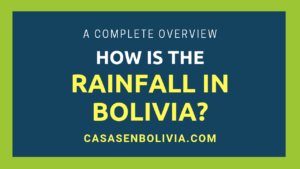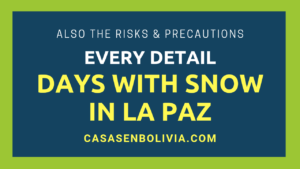Last Updated on February 15, 2025
Bolivia is a country with three very distinct climate zones, but only one of them experiences significant snowfall. In the western Altiplanic region, at high elevations, snow is quite common, primarily during the middle of the year. However, other regions of Bolivia may occasionally experience brief periods of snow.
Potosí is the coldest city in Bolivia (from May to July: 50°F/10°C during the day and 30°F/-1°C at night; record low: -0.4°F/-18°C on June 1st, 2010), but it’s closely followed by two other cities, El Alto and Oruro, which are only 3°F to 5°F (roughly 2°C to 3°C) warmer on average. La Paz is next, also being a quite cold city.
Here, we’ll discuss the top five coldest cities in Bolivia and their associated temperatures. We are Bolivian citizens, and we’ll provide you with all the details about how cold Bolivia’s principal cities actually get, during both winter/fall and summer/spring. You’ll also learn about other significant, very cold locations in Bolivia.
Which is the Coldest City in Bolivia?
In Bolivia, you’ll find three main cities that are very cold, especially during winter. They also have very similar temperature levels. These cities are:
- Potosí
- El Alto
- Oruro
Typically, these cities, *during part of winter and part of fall* (between May and July), will experience temperatures of 50°F (10°C) during the day and 30°F (-1°C) at night. For the rest of the year (from August to March), these cities will experience temperatures around 65°F (18°C) during the day and 45°F (7°C) at night.
Also, on the coldest days of the year, these cities will have very similar temperatures, sometimes even reaching 10°F (-12°C) at night and 40°F (4°C) during the day.
These three coldest cities in the country experience almost identical, very low temperatures at the same time of year because they share similar climatic and geographic characteristics:
- They are all at nearly the same elevation (~13,000 ft / ~4,000 m above sea level).
- They are located in the same Altiplanic region of Bolivia, in the western part of the country.
- They are near and adjacent to the Andes Mountains.
- They are situated on a flat, Altiplanic, desert-like, and cold expanse known as “The Altiplano.”
| Potosí (1st) | El Alto (2nd) | Oruro (3rd) | La Paz (4th) | Cochabamba (5th) | |
| Historical Lowest Temp. | -0.4°F (-18°C), June 30th, 2021 | 9.5°F (-12.5°C), June 1999 | 10.4°F (-12°C), June 24th, 2019 | 29.3°F (-1.5°C), June 27th, 2021* | 32.7°F (0.4°C), May 28th, 2021* |
| Avg. Temp. May to July | |||||
| During the day | 50°F (10°C) | 50°F (10°C) | 55°F (12°C) | 60°F (16°C) | 70°F (21°C) |
| At night | 30°F (-1°C) | 30°F (-1°C) | 35°F (2°C) | 40°F (4°C) | 50°F (10°C) |
| Avg. Temp. August to March | |||||
| During the day | 60°F (16°C) | 60°F (16°C) | 65°F (18°C) | 70°F (21°C) | 75°F (24°C) |
| At night | 40°F (4°C) | 40°F (4°C) | 45°F (7°C) | 45°F (7°C) | 55°F (13°C) |
| Avg. Elevation | ~13,419 ft (4,090 m) above sea level | ~13,615 ft (4,150 m) above sea level | ~12,254 ft (3,735 m) above sea level | ~11,893 ft (3,625 m) above sea level | ~8,392 ft (2,558 m) above sea level |
| Location | Altiplanic West | Altiplanic West | Altiplanic West | Altiplanic West | Temperate Center |
*Second-lowest historical temperature.
The 4th and 5th coldest cities in Bolivia are considerably warmer. These two cities are La Paz and Cochabamba, *which rarely struggle to reach freezing temperatures even on their coldest days*. We’ll discuss these five cities and regions in more detail in the next section.
The Top 5 Coldest Cities in Bolivia
1) Potosí
Although the three coldest cities in Bolivia have very similar temperature levels, *Potosí is, by a small margin, the coldest city in the country*. The primary reason is that this city is located further south in Bolivia, closer to the South Pole than the other two cities, Oruro and El Alto.
Even though El Alto is at a higher altitude, *Potosí typically experiences colder winds* originating from the polar south region of the world. As a result, Potosí is approximately 5°F (3°C) colder than Oruro and El Alto, with temperatures averaging 50°F (10°C) during the day and 30°F (-1°C) at night. It’s also worth noting that Potosí has recorded the lowest temperature for any Bolivian city.
Therefore, temperatures in Potosí often drop below freezing on nights from May to July, and you’ll still feel very cold in the mornings and afternoons during these months. You’ll need to wear appropriate clothing to cope with the city’s climate during this time.
On the other hand, from August to March, you’ll still feel cold, but the city rarely experiences freezing temperatures at night. People in this city *typically wear thick clothing year-round*, with occasional exceptions around October or November, when they experience warmer weather.
Historic lowest temperature: -0.4°F (-18°C) on June 1st, 2010.
Avg. temp. from May to July: 50°F (10°C) during the day and 30°F (-1°C) at night.
Avg. temp. from August to March: 60°F (16°C) during the day and 40°F (4°C) at night.
2) El Alto
El Alto is the second-coldest city in Bolivia, *but its temperatures are also very close to those of Potosí*. These cities have such similar climates that they experience almost identical average temperatures from May to July. Nevertheless, El Alto is, on average, perhaps 2°F or 3°F (1°C) warmer than Potosí.
El Alto is very cold because of:
- Its altitude (>13,600 ft / 4,145 m above sea level)
- Its proximity to the Andes Mountains
- Its location on flat Altiplanic land, without any mountains or hills to block winds coming from all directions, primarily from the Andes Mountains.
However, this city is the third-largest city in Bolivia, with a population exceeding 700,000 inhabitants.
During part of winter and fall (from May to July), temperatures will frequently drop to freezing levels on many nights, and days will feel very cold. Even from August to March, you’ll still experience cold temperatures. Residents of this city, like those in Potosí, typically wear thick clothing year-round, with almost no exceptions.
Historic lowest temperature: 9.5°F (-12.5°C) in June 1999.
Avg. temp. from May to July: 50°F (10°C) during the day and 30°F (-1°C) at night.
Avg. temp. from August to March: 60°F (16°C) during the day and 40°F (4°C) at night.
3) Oruro
Oruro, being the third-coldest city in Bolivia, is also not far behind the two previously mentioned cities in terms of temperature. At most, it’s only 3°F to 5°F (around 2°C) warmer than Potosí.
This is because Oruro is very similar to El Alto in that it’s situated on flat Altiplanic land, also near the Andes Mountains, *but it’s at a significantly lower altitude* (~12,250 ft / 3,735 m). This lower elevation is the reason why it’s slightly warmer.
Oruro also has two hills on its flanks, which shield the city from winds coming from all directions, so its geography contributes to warmer temperatures.
Nevertheless, this city is very cold year-round. It experiences its coldest months from May to July, with temperatures almost identical to those of El Alto and Potosí. Additionally, from August to March, you’ll still feel the cold weather. Like in the other two cities, residents almost always wear thick clothing throughout the year in Oruro.
Historic lowest temperature: 10.4°F (-12°C) on June 24th, 2019.
Avg. temp. from May to July: 55°F (12°C) during the day and 35°F (2°C) at night.
Avg. temp. from August to March: 65°F (18°C) during the day and 45°F (7°C) at night.
4) La Paz
La Paz is the fourth-coldest of Bolivia’s main cities, but it’s considerably warmer than the first three cities on this list.
La Paz is significantly different from Oruro, Potosí, and El Alto. It’s located at a lower elevation (~11,900 ft / 3,625 m), but the most important difference is that it’s situated within a deep canyon carved by a river, *providing it with protection from cold winds on both sides of the canyon*.
This protection is why the temperature in this city is significantly warmer, even though it’s only 600 ft to 700 ft (183 m to 213 m) lower in elevation than Oruro. Therefore, even on the coldest days of the year in La Paz (again, from May to July), *nighttime temperatures rarely reach freezing levels*.
Furthermore, daytime temperatures are quite comfortable for most of the year, *except from May to July*, when both days and nights are quite cold. However, for the rest of the year, people typically wear less thick clothing, and during months like October or November, they behave as if they were in a temperate or even subtropical climate, wearing only T-shirts, thin pants, shorts, and dresses.
Historic 2nd lowest temperature: 29.3°F (-1.5°C) on June 27th, 2021.
Avg. temp. from May to July: 60°F (16°C) during the day and 40°F (4°C) at night.
Avg. temp. from August to March: 70°F (21°C) during the day and 45°F (7°C) at night.
5) Cochabamba
You can’t really classify Cochabamba as a cold city, but among Bolivia’s main cities, it’s the fifth coldest.
Cochabamba actually enjoys a temperate climate and has one of the most pleasant weathers for living in Bolivia. This city also has temperatures very close to those of Sucre and Tarija, *but it’s somewhat colder*.
This is the first and only city on this list that is not located on the western side of Bolivia; it’s in the center of the country, in the middle of a valley within a mountainous corridor that divides Bolivia between its tropical East and its Altiplanic West.
Therefore, in this city, although it’s the fifth-coldest in Bolivia, *you’ll rarely feel cold*, regardless of whether it’s winter or summer. From May to July (also Cochabamba’s coldest months), you’ll still experience warm nights on most days, *with a few rare exceptions*, and during the day, you’ll always be able to wear light clothing, as residents of this city typically do.
Historic 2nd lowest temperature: 32.7°F (0.4°C) on May 28th, 2021.
Avg. temp. from May to July: 70°F (21°C) during the day and 50°F (10°C) at night.
Avg. temp. from August to March: 75°F (24°C) during the day and 55°F (13°C) at night.
Other Very Cold, Important Places in Bolivia
Uyuni Salt Flats (Potosí Department)
The Uyuni Salt Flats are one of Bolivia’s most well-known and most visited tourist destinations. However, many people are unaware that during part of winter and fall, *specifically from May to July, freezing temperatures are common there*.
The Uyuni Salt Flats can be as cold as Potosí City in most cases, but on some winter days, it can become even colder. *You need to be more cautious here* because you’ll only find small towns around this tourist destination, not a city to assist you in case of a threatening situation (like hypothermia) triggered by cold temperatures.
Therefore, especially if you visit this place from May to July, always bring clothing suitable for alpine climates and be well-prepared to face freezing temperatures almost every night, combined with snow in some cases. *Also, ensure that you have engaged a reputable tourist agency to visit this location.*
On the other hand, if you visit the Uyuni Salt Flats from August to March, you’ll enjoy warm enough temperatures to stay comfortable (temperatures similar to those in La Paz city). However, the salt terrain will be wet almost all the time, *not dry as it is in winter*, so you won’t be able to fully appreciate its beauty.
Historic 2nd lowest temperature: -7.8°F (-22°C) on June 30th, 2021.
Avg. temp. from May to July: 50°F (10°C) during the day and 28°F (-2°C) at night.
Avg. temp. from August to March: 65°F (18°C) during the day and 45°F (7°C) at night.
Red Lagoon (Potosí Department)
The Red Lagoon holds the unique distinction of having recorded the coldest temperature known in Bolivia’s modern history. This temperature was reached in 1996 and was -25.6°F (-32°C).
This location is another well-known and frequently visited tourist destination. It’s located in the department of Potosí, in the far southwest of the country, near the border with Chile. It’s one of Bolivia’s coldest places for two main reasons:
- This lake is at an even higher altitude (~14,030 ft / 4,278 m above sea level).
- It’s located in the southwest of the country and Potosí, so it receives more of the cold winds coming from the South Pole.
Be sure that when visiting this place, you hire a reputable tourist agency and *are prepared to face freezing temperatures year-round*. This advice applies not only to the Red Lagoon but also to the entire southwestern region of the Potosí department, where very cold temperatures are commonly recorded.
Historic lowest temperature: -25.6°F (-32°C) in June 1996.
Avg. temp. from May to July: 40°F (4°C) during the day and 19°F (-7°C) at night.
Avg. temp. from August to March: 55°F (12°C) during the day and 36°F (2°C) at night.
We have a comprehensive overview of Bolivia’s coldest places, with detailed information about each location, including the coldest one, available here: The coldest places of Bolivia, a full overview.
Conclusions:
In this article about Bolivia’s coldest cities, you’ve learned that Potosí is the coldest city in the country, reaching 50°F (10°C) during the day and 30°F (-1°C) at night during part of winter and part of fall (from May to July). You’ve also seen that two other cities are very close to these temperatures, El Alto and Oruro, being only about 3°F to 5°F (2°C to 3°C) warmer on average.
Additionally, you’ve learned that two other cities follow in this list: La Paz and Cochabamba. The first city is quite cold, mostly in winter, and the second is not considered a truly cold city, with a temperate climate year-round, but it’s still the fifth-coldest city in the country.
You’ve realized that people in the first four cities typically wear thick clothing year-round, with exceptions on some days in October or November, when summer is beginning. Finally, you’ve realized that there are also other very cold places, like the Uyuni Salt Flats and the Red Lagoon.
Always be sure to prepare yourself to face freezing climates in these cities and locations, particularly from May to July, and avoid the risk of even hypothermia in some cases.
We hope this information has been helpful. If you’d like to know every detail about the climate in Bolivia, including more information about the coldest cities, but also the warmest cities in the country, please visit our definitive guide here: How is the climate in Bolivia? A complete overview.
CasasenBolivia.com, information on living, working, investing, and traveling in Bolivia.








